Chapter Four—
The Courtly Response in Manuscripts by the Master of the Roman de Fauvel
Most manuscripts of the Grandes Chroniques that survive from the mid-fourteenth century were nonroyal copies made by Parisian booksellers for a courtly audience. The owners of these books, unlike the owners of the sophisticated, self-conscious royal manuscripts, did not belong to the long line of kings descended from Troy. Their ancestors had participated in battles, advised kings, or taken part in ceremonies described in the pages of the chronicle, yet rarely had they been protagonists. These courtly patrons therefore commissioned books that reflected their own roles in history by celebrating les français as well as le roy .[1]
The earliest owners of these nonroyal books are unknown. It is therefore hard to determine whether a given program of illustration was selected because of its importance to a specific patron. It has been established, however, that many of these manuscripts were painted by the same artists.[2] A careful comparison of their cycles of illustration with those of royal commissions like John the Good's can therefore provide a clear picture of the different perceptions of history—particularly dynastic history like that of the Grandes Chroniques de France —among contemporary audiences.
The distinctive perspective of the courtly audience during the reigns of the early Valois kings can be seen in three copies of the Grandes Chroniques (Switzerland, private collection; B.R. 5; and Castres, B.M.) dating from the 1330s. They were illustrated by an artist who belonged to a group of miniaturists known collectively as the Master of the Roman de Fauvel .[3] Working for members of the nobility, this group of artists decorated a wide variety of texts: ancient and French history, romances, moralized Bibles, and saints' lives.
Little is known about the earliest provenance of the Grandes Chroniques manuscripts illustrated by the Master of the Roman de Fauvel , although all seem to have been courtly. By the 1340s the manuscript in Castres belonged to the wife of the French chancellor, and in the fifteenth century the chronicles now in Brussels and Switzerland were in the collection of the duke of Burgundy.[4] The libraires who produced them could have had little access to royal models; their lives of Saint Louis, Philip III, and Philip IV are similar to one another but different from those of contemporary royal manuscripts. For example, in all the books from this group the life of Saint Louis incorporates the French translation of the continuation of Guillaume de Nangis used by Thomas of Maubeuge in his manuscript from the 1320s.
Like Thomas of Maubeuge, the designers of these books apparently took the taste of their patrons into account by personalizing both text and pictures. Thus an unedited text describing John of Jerusalem's trip to Rome to ask for papal assistance for the Holy Land was apparently included in the Brussels chronicle to satisfy the requirements of a patron with a particular interest in this incident. Because the pictorial cycles in these manuscripts are as varied as their texts, a comparison of texts and images should cast light on the perceptions of French history by noble audiences in the mid-fourteenth century.
In analyzing the nobility's use of history, it is important to take into account the stock illustrations often used in decorating medieval books. For instance, an illustration of the baptism of Clovis, the first Christian king of France, in the manuscript in Brussels (Fig. 51) is quite closely related to a similar illustration in the Castres manuscript (Fig. 52). Although certain figures change—a queen in the Brussels version becomes a monk in the Castres version, a monk in the Brussels illustration becomes a bishop in the Castres miniature—the basic configuration is identical; it is simply expanded from its miniature format in the Castres manuscript to fill an oblong space in the book in Brussels. The similarity between battle scenes painted in the Grandes Chroniques overseen by Thomas of Maubeuge (B.N. fr. 10132) in the 1320s and those in the gathering of the Castres chronicle on which the same artist collaborated demonstrates the continuity of such models.[5]
Because so many images in the Master of the Roman de Fauvel's Grandes Chroniques are stock scenes, it may be rash to suggest that their iconography expresses any individual owner's concerns. But we can credit the patron with the
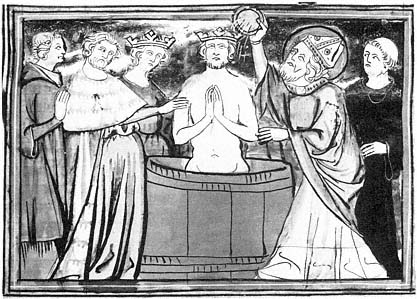
Figure 51
Baptism of Clovis. Grandes Chroniques de France . Bibliothèque Royale,
Ms. 5, fol. 13. Copyright Bibliothèque Royale Albert Ier, Brussels.
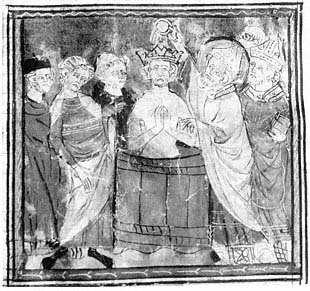
Figure 52
Baptism of Clovis. Grandes Chroniques de France .
Castres, Bibliothèque Municipale, fol. 11.
Photograph: Bibliothèque Municipale, Castres.
selection of subject matter and with the layout of the cycle, and we can feel confident that the patron played a role in including exceptional scenes that appear in no other copies of the chronicle decorated by the Master of the Roman de Fauvel . When considered in this way, these three books demonstrate three very different popular responses to royal history.
In the Grandes Chroniques now in Switzerland the text is more revealing than its illustrations. This is one of only five copies of the chronicle to replicate the dedicatory poems that Primat addressed to Philip III in the original presentation copy.[6] Such a feature does not necessarily mean that the manuscript is royal; it may, however, indicate that the patron was particularly interested in the royal associations evoked by the text. The placement and subjects of the illustrations are conventional. All but one picture in the manuscript mark major divisions in the chronicle and draw their subject matter from the paragraphs that follow.[7] One illustration subdivides a book, a picture of Louis VII, Emperor Conrad, and others riding on crusade (Fig. 53). This one exception, however, illustrates a text that was given special notice from the beginning of the chronicle tradition.[8] The pictures in this manuscript, then, are not used so much to shape the traditional royal history for a noble audience as to reinforce a text selected for its royal overtones.
A second chronicle, now in Brussels, is written in three columns and lavishly illustrated by 129 miniatures. It traces the history of France through the death of Philip V in 1321, using distinctive text and illustrations that relate thematically to John the Good's manuscript in their emphasis on dynastic continuity but differ
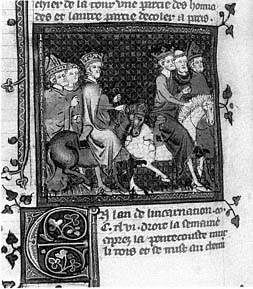
Figure 53
Louis VII and Emperor Conrad depart on
crusade. Grandes Chroniques de France .
Switzerland, private collection, fol. 219v.
Photograph: The Conway Library, Courtauld
Institute of Art.
significantly in their visual expression. Indeed, most of the images in the book are more closely related, visually, to those in Thomas of Maubeuge's manuscript. And, like Thomas's images, the majority of pictures in the Brussels manuscript derive exclusively from their text. Nor do they participate in an overall restructuring of the manuscript. With the exception of a pair of large miniatures illustrating the prologue and the beginning of Louis the Pious's life, virtually all the pictures in this manuscript are two columns wide and evenly distributed.[9] Thus the special character of this cycle of illustrations is to be found not in the structure of the cycle but in its treatment of subject matter.
The most visually striking miniatures in the Brussels manuscript are the pair that introduce the prologue to the Grandes Chroniques and the life of Louis the Pious, the son of Charlemagne. Each picture is three columns wide and fills two-thirds of a page. The first (Plate 2) represents a sequence of pagan and Christian kings of France, illustrating the rubric "Here begins the chronicles of France, first of the dukes who were first there and then of the Saracen kings, and following this, of all the Christian kings and all their deeds up to King Charles, son of King Philip the Fair, and of the ancestry from whom each is descended and of their offspring."[10] This image is comparable in form to that in John's manuscript (Plate 1) but differs significantly in content. In the introductory image of John's manuscript, dukes and kings are presented on pedestals like statues to provide special models of kingship and to emphasize the length of succession to the office of king. Standing in isolation from one another, they flank an image of the
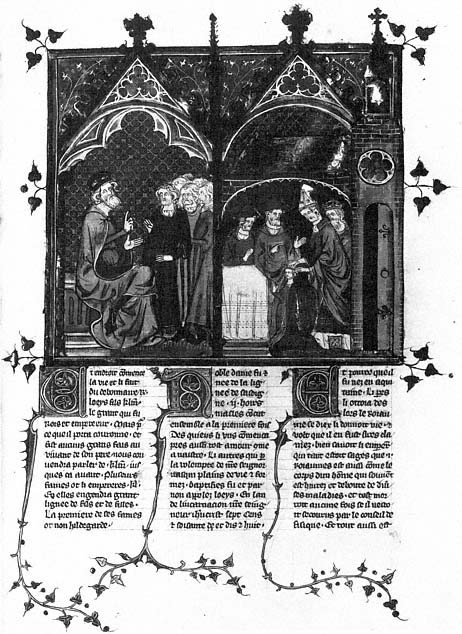
Figure 54
Charlemagne speaks to barons; Charlemagne supervises the coronation of Louis the
Pious. Grandes Chroniques de France . Bibliothèque Royale, Ms. 5, fol. 151.
Copyright Bibliothèque Royale Albert Ier, Brussels.
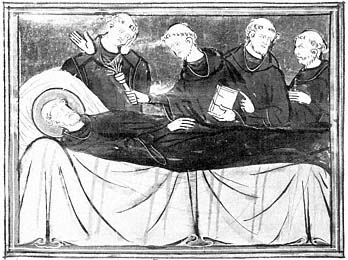
Figure 55
Death of Saint Benedict. Grandes Chroniques de France .
Bibliothèque Royale, Ms. 5, fol. 27v.
Copyright Bibliothèque Royale Albert Ier, Brussels.
inauguration of Pharamond.[11] In the Brussels manuscript, the kings interact with one another but are indistinguishable as individuals. This portrayal emphasizes ideas of smooth succession and continuity rather than the importance of lineage.
These nondynastic concerns also governed the selection of the other three-column miniature in the Brussels chronicle. In this picture (Fig. 54) generational continuity provides good government. On the left Charlemagne, regally enthroned, speaks with his barons; on the right Charlemagne supervises the pope's coronation of Louis the Pious as king of Aquitaine, a position that would provide him an apprenticeship in government.
Unique miniatures in the Brussels manuscript represent dramatic or miraculous events that do not involve the French king, scenes as diverse as the death of Saint Benedict (Fig. 55), King Louis of Germany torturing men to determine the justification for Charles the Bald's claim to rule (Fig. 56), or the appearance of Christ to Emperor Maurice of Constantinople (Fig. 57). Such images provide insight into the owner's interest in miracles and religious devotion—and into the personalized character of the illustration program.
The popularity of devotion to relics accounts for such scenes as the translation of Christ's robe (fol. 63), Charlemagne's prayers before the Crown of Thorns (Fig. 58), and the earliest representation that I have found in the Grandes Chroniques of the translation of the relics of Saint Louis (Fig. 59) during the reign of Philip IV. The devotional nature of this scene contrasts with the treatment of Saint Louis in John the Good's book, which places Louis's life within a dynastic frame.
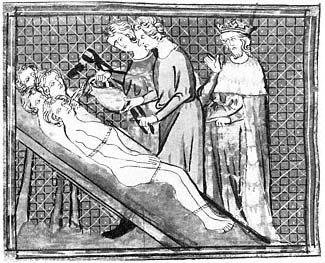
Figure 56
Louis of Germany tortures men. Grandes Chroniques
de France . Bibliothèque Royale, Ms. 5, fol. 184v.
Copyright Bibliothèque Royale Albert Ier, Brussels.
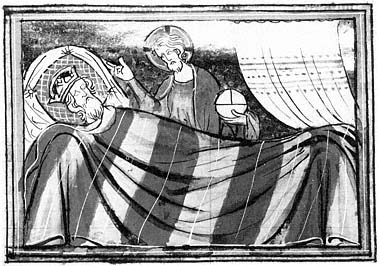
Figure 57
Appearance of Christ to Emperor Maurice of Constantinople.
Grandes Chroniques de France . Bibliothèque Royale, Ms.
5, fol. 72v. Copyright Bibliothèque Royale Albert Ier, Brussels.
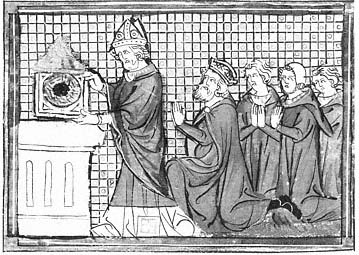
Figure 58
Charlemagne's prayer before the Crown of Thorns. Grandes
Chroniques de France . Bibliothèque Royale, Ms. 5, fol. 128.
Copyright Bibliothèque Royale Albert Ier, Brussels.
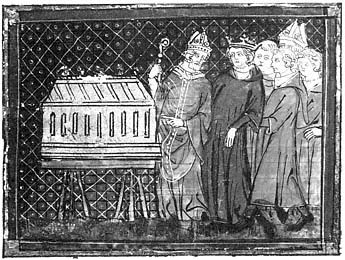
Figure 59
Translation of relics of Saint Louis. Grandes Chroniques de
France . Bibliothèque Royale, Ms. 5, fol. 327.
Copyright Bibliothèque Royale Albert Ier, Brussels.
The special text and image added to this manuscript provide an excellent example of its nondynastic aim. Between the end of the life of Philip Augustus and the beginning of that of Louis VIII is a chapter (fol. 308) illustrated by the arrival of King John of Jerusalem at Rome (Fig. 60), describing how King John came to Rome to seek help and was supported by both the pope and Frederick, the Holy Roman Emperor, whose daughter John married. The following text establishes that John was effectively the last Christian King of the Holy Land. A royal manuscript might suggest that the French king should be the successor to John or, at the very least, might call for a crusade, but the Brussels text does neither. Instead, it changes the subject and describes once again the death and burial of Philip Augustus, perhaps to provide a transition to the life of Philip's son, Louis VIII, which follows the description of Philip Augustus's death.[12]
The third manuscript, located in Castres, uses exceptional images to personalize and universalize the Grandes Chroniques . As such it is the most distinctive of the three attributed to the Master of the Roman de Fauvel . Unlike the other two, this Grandes Chroniques was frequently updated, taking its present shape in a series of four or five campaigns over a period of 20 to 25 years. As originally planned, the book was the work of two scribes who wrote the history of France through the death of Philip Augustus, a frequent terminus for the Grandes Chroniques and the endpoint for the manuscript in the Swiss private collection. This section of the chronicle was illustrated by three artists, each of whom worked on separate gatherings: the Master of the Roman de Fauvel painted all but two gatherings, one of which was the work of the first artist from the Grandes Chroniques
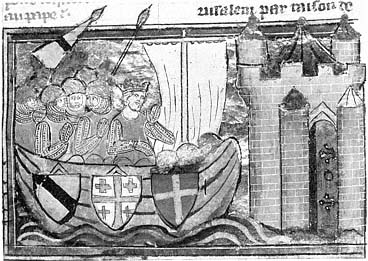
Figure 60
King John of Jerusalem arrives at Rome. Grandes Chroniques de
France . Bibliothèque Royale, Ms. 5, fol. 308.
Copyright Bibliothèque Royale Albert Ier, Brussels.
commissioned in 1318 from Thomas of Maubeuge. A third scribe subsequently continued the history through the life of Philip V. This section was illustrated by a fourth artist, whose work can be dated to the 1340s and 1350s on the basis of costume.[13] Finally, the book was continued again in one or two stages that extend the history through the life of Philip of Valois. Spaces for illuminations were left in this section but were never filled.
This frequent updating suggests that the manuscript in Castres was as vital to its owners as royal copies of the chronicle had been to Philip III and John the Good. Thus, even if we cannot be completely sure of the identity of the original patron of this Grandes Chroniques , we may gain our clearest insights by examining how this highly valued manuscript reflects the historical perspective of its nonroyal audience.
The provenance of the Grandes Chroniques in Castres suggests that the earliest owner was a figure at court. An inscription added above the chapter describing the Battle of Courtrai (Plate 3) in the first continuation is the earliest indication of ownership. Written in a different hand from that of the text, the inscription states, "These chronicles belong to Madame Jeanne d'Amboise, lady of Revel and of Tisauges,"[14] thus providing a precise date for the inscription. After the death of her second husband, the Seigneur de Tisauges, Jeanne married Guillaume Flote, Seigneur de Revel and chancellor of France from 1338 to 1348, whose first wife died in 1339.[15] The first owner of the book was probably Jeanne, a member of her family, or her husband. Guillaume Flote may have been the owner, since he commissioned other works decorated by this artist.[16]
The placement of Jeanne's ex-libris strengthens the hypothesis that the Grandes Chroniques was given to Jeanne after her marriage. It appears above a miniature that represents one in a series of battles that Philip IV waged against rebellious Flemish forces between 1297 and 1304, when Jeanne was young. These battles were important for her family's history because her grandfather, Anseau de Chevreuse, the bearer of the oriflamme of France, the royal flag associated with Charlemagne, was killed during the campaign.[17] Had this been Jeanne's personal copy of the text, the Battle of Mons-en-Pévèle, where her grandfather was killed, would probably have been illustrated. Since the Battle of Courtrai was the only image in the book to commemorate the Flemish campaign, however, it received her ex-libris .
The Battle of Courtrai had special significance for Jeanne's husband. Guillaume Flote's father, Pierre, was one of the few loyal French who remained with Robert of Artois and died at Courtrai after the rest of the French forces fled the field. In a rare illustration to this chapter the miniature below Jeanne's signature glorifies the bravery of men like Robert of Artois and Pierre Flote. It shows the turning point in the battle, when Robert of Artois, resplendent in his arms, rode directly at the Flemish who attacked as most of the French fled.[18] In the miniature a few soldiers visible beyond Robert fight with him. It is clear that Robert and this noble minority are doomed; they will take their places with the dead soldiers who litter the ground.
The illustration to the Battle of Courtrai is thus one of those rare instances when the royal history recorded in the Grandes Chroniques merges with the history of the nobility. Such moments of convergence are rare, and representations of them
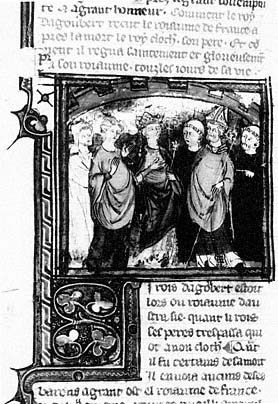
Figure 61
Abbot and monks of Saint-Denis before Dagobert.
Grandes Chroniques de France . Castres,
Bibliothèque Municipale, fol. 73.
Photograph: Bibliothèque Municipale, Castres.
are exceptional. Programs of decoration for the nobility more frequently sought to illustrate universal rather than personal elements of history.
Exceptional miniatures in the pictorial cycle of Jeanne d'Amboise's book provide insight into the perception of past and present French history by the early fourteenth-century court. Of 65 miniatures, 13 are unique among those illustrating the Master of the Roman de Fauvel's manuscripts. These treat three broad themes: the first reveals the extent to which Dionysian legends fascinated a broad audience, the second examines the universal moral applications of French history, and the third concerns the relationship between the king and his vassals. Similar themes are addressed pictorially in John the Good's royal book, but Jeanne d'Amboise's manuscript approaches these themes differently, both in the concerns expressed and in the mode of presentation.
The Dionysian imagery in this manuscript centers on the two most famous royal patrons of the abbey: Dagobert and Charles the Bald. In the miniature that
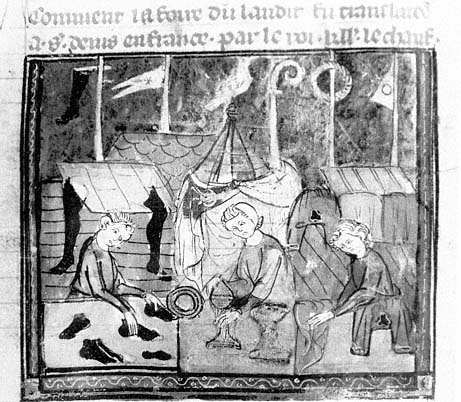
Figure 62
Fair of Lendit. Grandes Chroniques de France . Castres, Bibliothèque Municipale, fol.
122v. Photograph: Bibliothèque Municipale, Castres.
should represent Dagobert's coronation (Fig. 61) a prominent place is given to a delegation of Benedictine monks led by their abbot to confront the king. The text makes clear that this illustrates the founding of the abbey. A second image represents a later benefice allegedly given to the abbey by Charles the Bald (Fig. 62)—the Fair of Lendit. This picture, representing a shoe merchant, goldsmith, and clothes salesman at the fair, cuts its chapter in two in order to appear directly above the text explaining that Charles the Bald moved the fair from Aix-la-Chapelle to Saint-Denis at the same time that he presented a collection of relics of Christ's passion to the abbey.[19] Those who came to the fair and adored the relics were given a special indulgence. In Jeanne d'Amboise's book the merchants—part of the concrete reality that any visitor to the fair would see—are represented in the miniature rather than the legendary events or the ostentation of the relics that decorated John the Good's book (Fig. 63). Thus the emphasis would seem to be on economic reality rather than devotion to an illustrious ancestor (as in the contemporary royal manuscript). The final Dionysian picture expands the traditional representation of Charles the Bald's vision of hell (Fig. 64), which chastised him
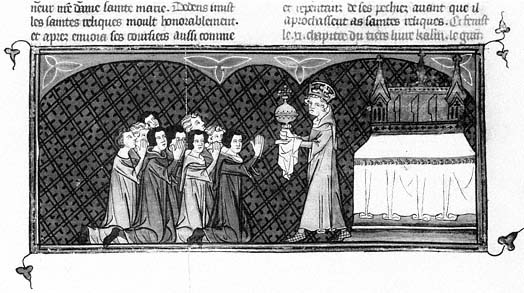
Figure 63
Ostentation of the relics. Grandes Chroniques de France . British Library, Royal 16 G VI, fol. 163.
By permission of the British Library.
into leading a good life. A second vision (Fig. 65), in which Charles the Bald appears to a monk of Saint-Denis seven years after his death, is represented less frequently. At this appearance Charles urged the monk to persuade the king of France and the abbot of Saint-Denis to move his body to the abbey.
These Dionysian images, very different in tone from those included in royal manuscripts, may reflect a popular perception of French history. The Fair of Lendit was an event experienced by many in Paris. Jongleurs sang chansons de geste , which, like the sermons given by the monks at the fair, explained how the relics came to the abbey. Moreover, the kings featured in the Dionysian pictures of Jeanne's Grandes Chroniques —Dagobert and Charles the Bald—were the most visible of Merovingian and Carolingian rulers buried at Saint-Denis. Anyone touring the array of royal tombs in the abbey church would be struck by Dagobert's elaborate stone tomb near the altar and Charles the Bald's golden tomb in the place of honor in the choir.
The universal moral message of French history is the theme of one of the most interesting of the unique miniatures in this manuscript—a moral exemplum drawn from the life of Charlemagne. This picture (Fig. 66) illustrates the confrontation between Charlemagne and Agolant, a Moslem leader, during Charlemagne's crusade to rid Spain of pagans. One of only two Grandes Chroniques to illustrate this theme, Jeanne's book is the only one in which the picture is carefully placed to subdivide the chapter so that it is near the text that draws a broad Christian moral.[20] The chapter recounts how Agolant decided that it
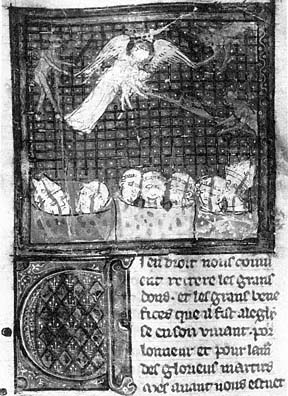
Figure 64
Charles the Bald's vision of hell. Grandes Chroniques
de France . Castres, Bibliothèque Municipale, fol. 177.
Photograph: Bibliothèque Municipale, Castres.
was expedient to convert to Christianity after a series of defeats at the hands of Charlemagne's armies. He came to Charlemagne to be baptized and arrived just as the French sat down to dinner. Agolant noticed that the diners were seated in groups and inquired about their identities. Concentrating on the varied religious groups, Charlemagne explained how bishops and priests, monks and abbots, and canons regular, functioned in the religious hierarchy. When asked the identity of 12 scruffily dressed men crouching on the dirt far from him, Charlemagne responded that they were poor men, "messengers of Christ," who were fed every day in memory of the apostles. Agolant was unimpressed by Charlemagne's treatment of Christ's messengers. He refused baptism, withdrew his troops, and recommenced battle. The Grandes Chroniques draws the broad and obvious moral: "If Charlemagne lost King Agolant and his men, who would not be baptized because he saw the poor treated so villainously, what will happen on the day of judgment to those who in this mortal life despised the poor and treated them villainously? . . . Just as the pagan refused baptism because he did not see good deeds in Charlemagne, I
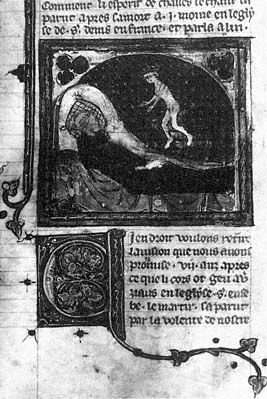
Figure 65
Vision of a monk of Saint-Denis. Grandes
Chroniques de France . Castres, Bibliothèque
Municipale, fol. 176v.
Photograph: Bibliothèque Municipale, Castres.
do not doubt that our Lord will refuse us the faith of baptism on judgment day if he sees no good works."[21]
The theme of the relationship between the nobility and the king is expressed in this manuscript through events from the life of Philip Augustus. Two illustrations represent the provisions made for governing the country when the king was absent and the punishment that awaited those vassals who rebelled against the king. The first image (Fig. 67) represents Philip Augustus speaking to councillors and establishing the testament that he made when he left for the Crusades with Richard the Lionheart. Philip's testament designated those who should rule during his absence and made provisions for a regency if he were to die in the Holy Land. The rubric accompanying this picture emphasizes not Philip's wisdom as ruler, but the effect of his action on those left behind. This scene receives a different emphasis in John the Good's book, the only other to illustrate it. Whereas the traditional rubric in John's book reads, "The testament which King Philip established before his death," the rubric in Jeanne d'Amboise's manuscript is expanded to stress the
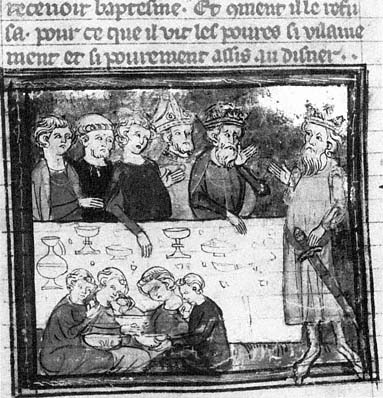
Figure 66
Charlemagne and Agolant. Grandes Chroniques de France . Castres,
Bibliothèque Municipale, fol. 128.
Photograph: Bibliothèque Municipale, Castres.
theme of good government: "How the king Philip [the] God-given arranged his testament before he left France to go on crusade and how he provided for the needs of the realm and for the profit of all the common people."[22]
Philip Augustus's provisions for the common good of his loyal subjects were matched in intensity by his punishment of vassals who broke his oath. The clearest illustration of this theme is an event in the story of the Battle of Bouvines, which pitted the French forces against those of the English king and the Holy Roman Emperor. One of the knights who made the battle possible was Ferrand, count of Hainaut and brother-in-law of the French king, who allowed the English and German forces to assemble at his chateau and allied himself with them against Philip Augustus, his liege lord. Two scenes represent Ferrand's punishment. First a standard workshop scene (Fig. 27) represents the French victory at Bouvines at which he was captured; then an exceptional image (Fig. 68) shows Ferrand being paraded in Philip's triumphal entry into Paris. The text describes the crowds berating the count on his way to Paris; it gives little attention to Philip's welcome.[23]
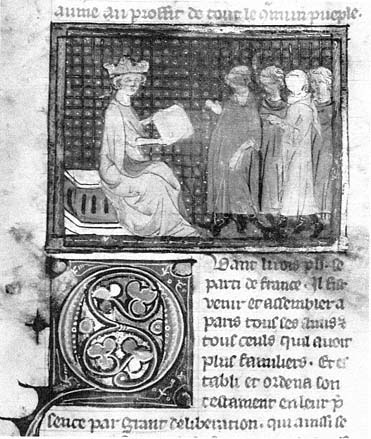
Figure 67
Philip Augustus's testament. Grandes Chroniques de France .
Castres, Bibliothèque Municipale, fol. 263.
Photograph: Bibliothèque Municipale, Castres.
Ferrand's punishment is the exclusive focus of the miniature, which does not even include the king.
John the Good's chronicle was designed to gather suitable models of kingship for the heir to the throne and, in the process, to inspire John to be a good king like Saint Louis, whose reign ends the manuscript. John probably read the book this way. For him the events recorded in the Grandes Chroniques were living history, which affected him and in which he would participate.
The books decorated by the Master of the Roman de Fauvel present a very different view. They did not provide a model of living history to their owners, but rather testified to popular reactions to the French past. For the patron of the book now in Switzerland (private collection), possession of the royal text was most important; illustration did little to shape a personal reading of the chronicle. In the chronicle now in Brussels (B.R. 5) pictures reveal an awareness of the importance of succession and the role of such models of kingship as Charlemagne in guaranteeing it. The idea of the miraculous and the devotion to such kings as Saint
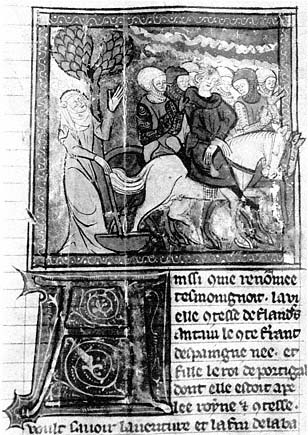
Figure 68
Count Ferrand led to Paris. Grandes Chroniques de
France . Castres, Bibliothèque Municipale, fol. 288.
Photograph: Bibliothèque Municipale, Castres.
Louis and Dagobert, celebrated in contemporary chansons de geste and hagiography, were, however, much more important to this book than any dynastic theme. Of the three, only Jeanne d'Amboise's chronicle could be termed instructional as John the Good's Grandes Chroniques had been, but it was instructional only on the most popular and universal level. The readers of Jeanne's chronicle knew that they would probably never have a place in its pages, and perhaps as a result even the exceptional pictures in this book reinforce generalized readings of the text.